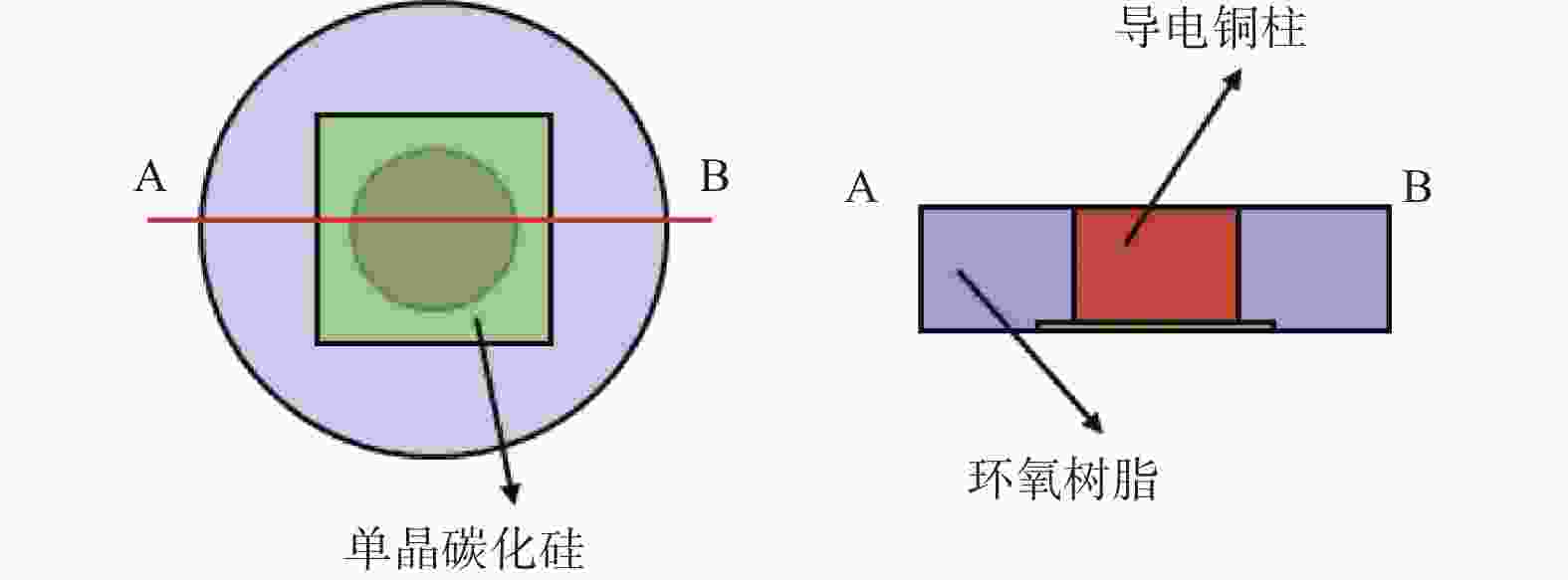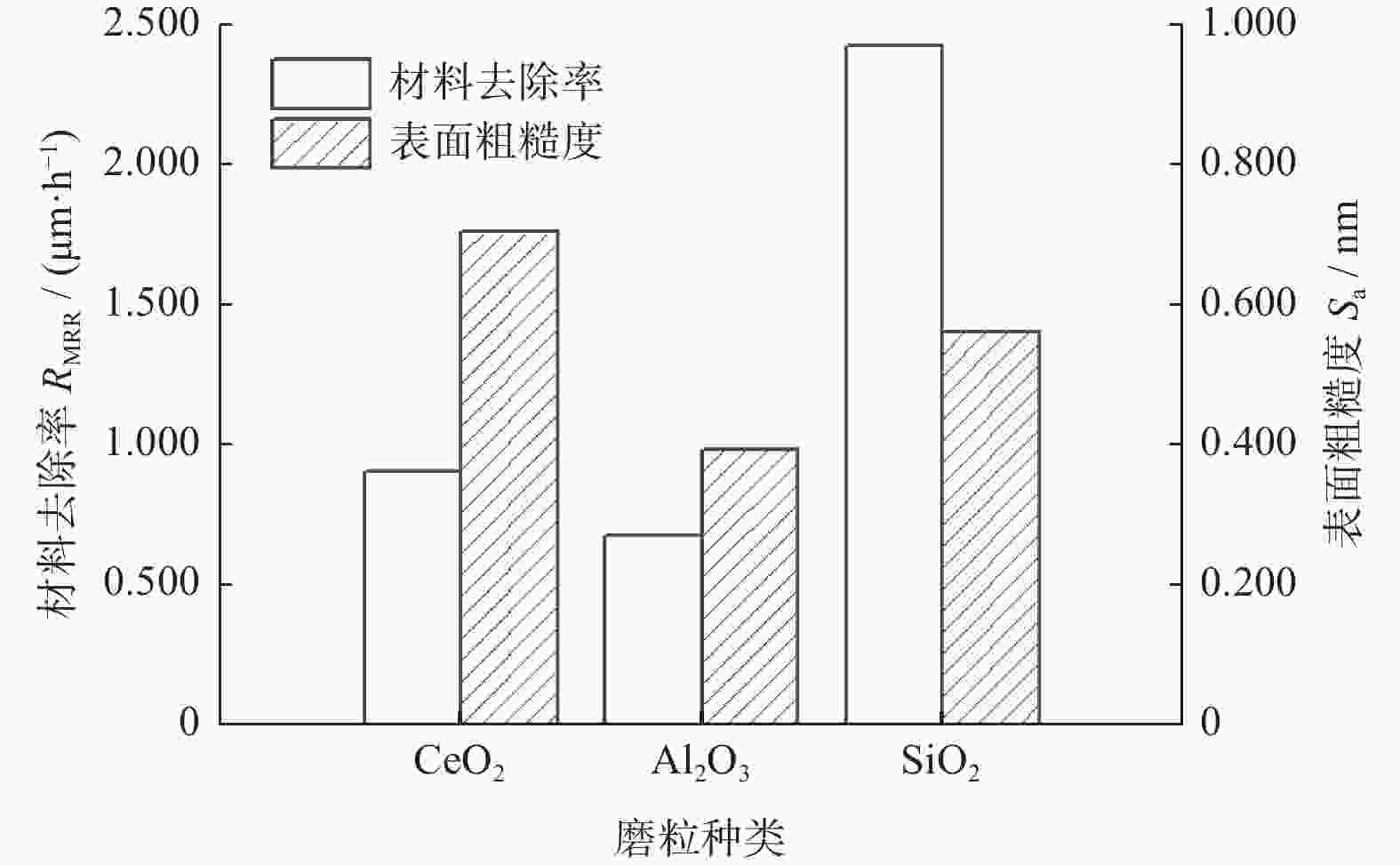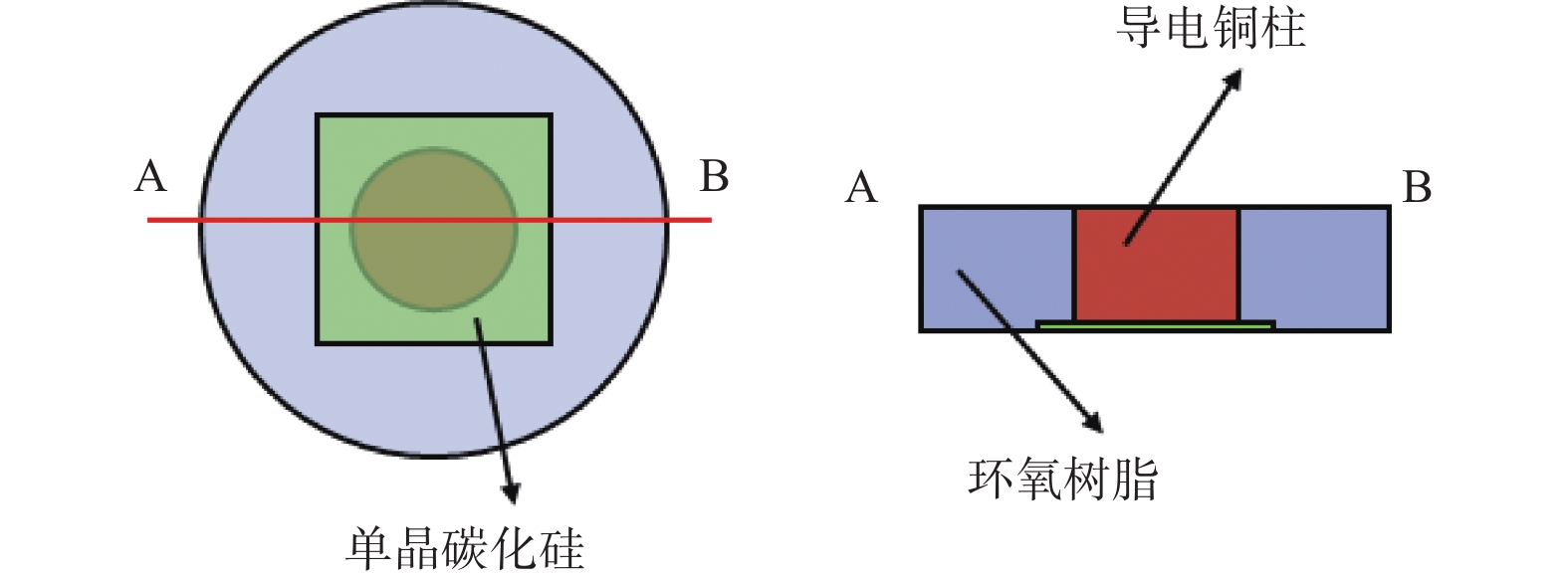Composition design and optimization of electrochemical mechanical polishing slurry for single crystal SiC
-
摘要: 单晶碳化硅具有高硬度和高化学惰性,化学机械抛光方法难以同时保证其加工效率和表面质量。电化学机械抛光具有较高的材料去除率,是加工碳化硅的一种有效方法。然而,目前针对碳化硅电化学机械抛光液的相关研究还较为缺乏。为此,首先通过单因素实验确定电化学机械抛光液中导电介质和磨粒种类,然后分析导电介质和磨粒浓度以及抛光液pH值对材料去除率和表面粗糙度的影响规律,最终确定抛光液的最佳参数。结果表明:在抛光液以NaCl为导电介质,SiO2为抛光磨粒时,碳化硅具有较好的抛光效率和表面质量,其材料去除率和表面粗糙度随着NaCl浓度的增大而增大,随着磨粒浓度的增加先增大后趋于稳定;当NaCl浓度为0.6 mol/L、SiO2质量分数为6%、抛光液pH值为7时,可以兼顾碳化硅抛光的材料去除率和表面粗糙度Sa,其值分别为 2.388 μm/h和0.514 nm。Abstract: Objectives: Single crystal silicon carbide (SiC) is known for its high hardness and high chemical inertness, making it chanllenging to process effectively using traditional chemical mechanical polishing (CMP) methods. CMP often struggles to balance processing efficiency and surface quality for SiC. Electrochemical mechanical polishing (ECMP) is an effective method to achieve high material removal rates (MRR) and excellent surface quality when processing SiC. This study explores the main components and optimal ratios of SiC ECMP slurry through process testing. Methods: Using MRR and surface roughness as evaluation indicators, the types of conductive medium and abrasive particles in the ECMP slurry are first determined through single-factor experiments. Then, the influences of the conductive medium types, abrasive particle concentration, and the pH value of the polishing slurry, on both MRR and surface roughness, are analyzed to identify the optimal slurry parameters. Results: The results of the experiments indicate that when NaCl is used as the conductive medium and SiO2 as the polishing abrasive, SiC achieves both good polishing efficiency and surface quality. The increase in NaCl concentration enhances the electrochemical oxidation of SiC, leading to an increase in MRR and surface roughness. As the concentration of abrasives increases, the surface conductivity of SiC improves, boosting both material removal efficiency and surface roughness. However, after reaching a certain abrasive concentration, the oxidation state of SiC stabilizes, and both MRR and surface roughness tend to reach a constant value. When the polishing slurry is acidic, electrochemical oxidation of SiC is inhibited, leading to a reduced MRR. Conversely, when the slurry is alkaline, abrasive particles undergo chemical reactions, resulting in poor polishing surface quality. A neutral slurry effectively balances both MRR and surface quality. The optimal slurry paramaters for achieving this balance are a NaCl concentration of 0.6 mol/L, a SiO2 mass fraction of 6%, and a pH value of 7. Under these conditions, the MRR and surface roughness of SiC polishing were found to be 2.388 μm/h and 0.514 nm, respectively. Conclusions: The low oxidation rate of SiC, due to its high chemical inertness, is a key factor limiting the polishing efficiency in traditional CMP methods. ECMP overcomes this limitation by replacing chemical oxidation with electrochemical oxidation, allowing for both high polishing efficiency and superior surface quality of SiC.
-
表 1 碳化硅ECMP实验参数
Table 1. Experimental parameters for ECMP of SiC
工艺参数 数值 抛光转速 n / (r·min−1) 50 抛光压力 p / kPa 100 抛光时间 t / min 45 抛光液流速 qv / (mL·min−1) 15 表 2 抛光电压对碳化硅ECMP 的影响
Table 2. The effect of polishing voltage on ECMP of SiC
抛光电压 U / V 表面粗糙度 Sa / nm 2 0.520 4 0.641 6 0.706 表 3 碳化硅和磨粒的硬度
Table 3. Hardness of SiC and abrasives
材料种类 维氏硬度Hv / GPa SiC 24.0~28.0 Al2O3 12.0~23.0 CeO2 5.0~7.5 SiO2 7.5 -
[1] MADAR R. Silicon carbide in contention [J]. Nature,2004,430(7003):974-975. doi: 10.1038/430974a [2] EDDY C R, GASKILL D K. Silicon carbide as a platform for power electronics [J]. Science,2009,324(5933):1398-1400. doi: 10.1126/science.1168704 [3] MILLAN J, GODIGNON P, PERPINA X, et al. A survey of wide bandgap power semiconductor devices [J]. IEEE Transactions on Power Electronics,2014,29(5):2155-2163. doi: 10.1109/TPEL.2013.2268900 [4] ZOLPER J C. Emerging silicon carbide power electronics components: Applied power electronics conference and exposition [C]. Austin TX: Twentieth Annual IEEE, 2005. [5] CVETKOVIĆ S, MORSBACH C, RISSING L. Ultra-precision dicing and wire sawing of silicon carbide (SiC) [J]. Microelectronic Engineering,2011,88(8):2500-2504. doi: 10.1016/j.mee.2011.02.026 [6] WANG H, GAO S, GUO X, et al. Atomic understanding of the plastic deformation mechanism of 4H-SiC under different grain depth-of-cut during nano-grinding [J]. Journal of Electronic Materials,2023,52(7):4865-4877. doi: 10.1007/s11664-023-10457-z [7] GAO S, WANG H, HUANG H, et al. Molecular simulation of the plastic deformation and crack formation in single grit grinding of 4H-SiC single crystal [J]. International Journal of Mechanical Sciences,2023,247:108147. doi: 10.1016/j.ijmecsci.2023.108147 [8] YAN Q S, CHEN S K, PAN J S, et al. Surface and subsurface damage characteristics and material removal mechanism in 6H-SiC wafer grinding [J]. Materials Research Innovations,2014,18(sup2):S2.742-S2.747. doi: 10.1179/1432891714Z.000000000522 [9] HSIEH C H, CHANG C Y, HSIAO Y-K, et al. Recent advances in silicon carbide chemical mechanical polishing technologies [J]. Micromachines,2022,13(10):1752. doi: 10.3390/mi13101752 [10] WANG W, LIU W, SONG Z. Two-step chemical mechanical polishing of 4H-SiC(0001) wafer [J]. ECS Journal of Solid State Science and Technology,2021,10(7):74004. doi: 10.1149/2162-8777/ac12de [11] KATO T, WADA K, HOZOMI E, et al. High throughput SiC wafer polishing with good surface morphology [J]. Materials Science Forum,2007(556/557):753-756. doi: 10.4028/www.scientific.net/MSF.556-557.753 [12] WANG X, CHEN J, BU Z, et al. Accelerated C-face polishing of silicon carbide by alkaline polishing slurries with Fe3O4 catalysts [J]. Journal of Environmental Chemical Engineering,2021,9(6):106863. doi: 10.1016/j.jece.2021.106863 [13] LU J, CHEN R, LIANG H, et al. The influence of concentration of hydroxyl radical on the chemical mechanical polishing of SiC wafer based on the fenton reaction [J]. Precision Engineering,2018,52:221-226. doi: 10.1016/j.precisioneng.2017.12.011 [14] YIN T, DOI T, KUROKAWA S, et al. Polishing characteristics of MnO2 polishing slurry on the Si-face of SiC wafer [J]. International Journal of Precision Engineering and Manufacturing,2018,19(12):1773-1780. doi: 10.1007/s12541-018-0206-9 [15] CHEN G, LI J, LONG J, et al. Surface modulation to enhance chemical mechanical polishing performance of sliced silicon carbide Si-face [J]. Applied Surface Science,2021,536:147963. doi: 10.1016/j.apsusc.2020.147963 [16] DENG J, LU J, YAN Q, et al. Enhancement mechanism of chemical mechanical polishing for single-crystal 6H-SiC based on electro-fenton reaction [J]. Diamond and Related Materials,2021,111:108147. doi: 10.1016/j.diamond.2020.108147 [17] YAMAMURA K, TAKIGUCHI T, UEDA M, et al. High-integrity finishing of 4H-SiC(0001) by plasma-assisted polishing [J]. Advanced Materials Research,2010(126/127/128):423-428. doi: 10.4028/www.scientific.net/AMR.126-128.423 [18] DENG H, TAKIGUCHI T, UEDA M, et al. Damage-free dry polishing of 4H-SiC combined with atmospheric-pressure water vapor plasma oxidation [J]. Japanese Journal of Applied Physics,2011,50(8):8JG05.1-8JG05.4. doi: 10.1143/JJAP.50.08JG05 [19] YAMAMURA K, TAKIGUCHI T, UEDA M, et al. Plasma assisted polishing of single crystal SiC for obtaining atomically flat strain-free surface [J]. CIRP Annals,2011,60(1):571-574. doi: 10.1016/j.cirp.2011.03.072 [20] DENG H, YAMAMURA K. XTEM observation of 4H-SiC(0001) surfaces processed by plasma assisted polishing [J]. Advanced Materials Research,2012,497:156-159. doi: 10.4028/www.scientific.net/AMR.497.156 [21] ISHIKAWA Y, MATSUMOTO Y, NISHIDA Y, et al. Surface treatment of silicon carbide using TiO2(IV) photocatalyst [J]. Journal of the American Chemical Society,2003,125(21):6558-6562. doi: 10.1021/ja020359i [22] OHNISHI O, DOI T, KUROKAWA S, et al. Effects of atmosphere and ultraviolet light irradiation on chemical mechanical polishing characteristics of SiC wafers [J]. Japanese Journal of Applied Physics,2012,51(5S): 05EF05. doi: 10.1143/JJAP.51.05EF05 [23] YUAN Z, HE Y, SUN X, et al. UV-TiO2 photocatalysis-assisted chemical mechanical polishing 4H-SiC wafer [J]. Materials and Manufacturing Processes,2018,33(11):1214-1222. doi: 10.1080/10426914.2017.1364855 [24] GAO B, ZHAI W, ZHAI Q, et al. Novel polystyrene/CeO2-TiO2 multicomponent core/shell abrasives for high-efficiency and high-quality photocatalytic-assisted chemical mechanical polishing of reaction-bonded silicon carbide [J]. Applied Surface Science,2019,484:534-541. doi: 10.1016/j.apsusc.2019.04.037 [25] BARR H, SANO Y, MIMURA H, et al. Novel abrasive-free planarization of 4H-SiC (0001) using catalyst [J]. Journal of Electronic Materials,2006,35(8):L11-L14. doi: 10.1007/s11664-006-0218-6 [26] ISOHASHI A, SANO Y, OKAMOTO T, et al. Study on reactive species in catalyst-referred etching of 4H–SiC using platinum and hydrofluoric acid [J]. Materials Science Forum,2013, 740/741/742:847-850. doi: 10.4028/www.scientific.net/MSF.740-742.847 [27] KUBOTA A, YAGI K, MURATA J, et al. A study on a surface preparation method for single-crystal SiC using an Fe catalyst [J]. Journal of Electronic Materials,2009,38(1):159-163. doi: 10.1007/s11664-008-0583-4 [28] OKAMOTO T, SANO Y, TACHIBANA K, et al. Improvement of removal rate in abrasive-free planarization of 4H-SiC substrates using catalytic platinum and hydrofluoric acid [J]. Japanese Journal of Applied Physics,2012,51(4):6501. doi: 10.1143/JJAP.51.046501 [29] LI C, BHAT I B, WANG R, et al. Electro-chemical mechanical polishing of silicon carbide [J]. Journal of Electronic Materials,2004,33(5): 481-486. doi: 10.1007/s11664-004-0207-6 [30] YANG X, OHKUBO Y, ENDO K, et al. AFM observation of initial oxidation stage of 4H-SiC(0001) in electrochemical mechanical polishing [J]. Procedia CIRP,2018,68:735-740. doi: 10.1016/j.procir.2017.12.129 [31] YANG X, SUN R, OHKUBO Y, et al. Investigation of anodic oxidation mechanism of 4H-SiC(0001) for electrochemical mechanical polishing [J]. Electrochimica Acta,2018,271:666-676. doi: 10.1016/j.electacta.2018.03.184 [32] YANG X, YANG X, GU H, et al. Charge utilization efficiency and side reactions in the electrochemical mechanical polishing of 4H-SiC (0001) [J]. Journal of the Electrochemical Society,2022,169(2):023501. doi: 10.1149/1945-7111/ac4b1f [33] LIU N, YI R, DENG H. Study of initiation and development of local oxidation phenomena during anodizing of SiC [J]. Electrochemistry Communications,2018,89:27-31. doi: 10.1016/j.elecom.2018.02.013 [34] YANG X, YANG X, KAWAI K, et al. Highly efficient planarization of sliced 4H–SiC(0001) wafer by slurryless electrochemical mechanical polishing [J]. International Journal of Machine Tools and Manufacture,2019,144:103431. doi: 10.1016/j.ijmachtools.2019.103431 [35] YANG X, YANG X, GU H, et al. Efficient and slurryless ultrasonic vibration assisted electrochemical mechanical polishing for 4H–SiC wafers [J]. Ceramics International,2022,48(6):7570-7583. doi: 10.1016/j.ceramint.2021.11.301 [36] YANG X, YANG X, KAWAI K, et al. Novel SiC wafer manufacturing process employing three-step slurryless electrochemical mechanical polishing [J]. Journal of Manufacturing Processes,2021,70:350-360. doi: 10.1016/j.jmapro.2021.08.059 [37] MURATA J, NAGATOMO D. Investigation of electrolytic condition on abrasive-free electrochemical mechanical polishing of 4H-SiC using Ce thin film [J]. ECS Journal of Solid State Science and Technology,2020,9(3):34002. doi: 10.1149/2162-8777/ab7672 [38] MURATA J, YODOGAWA K, BAN K. Polishing-pad-free electrochemical mechanical polishing of single-crystalline SiC surfaces using polyurethane-CeO2 core-shell particles [J]. International Journal of Machine Tools & Manufacture,2017,114:1-7. doi: 10.1016/j.ijmachtools.2016.11.007 [39] GAO B, ZHAI W J, ZHAI Q, et al. Electro-chemical mechanical polishing of 4H-SiC for scratch-free surfaces with less oxide layer at high efficiency [J]. ECS Journal of Solid State Science and Technology,2019,8(11):P677-P684. doi: 10.1149/2.0031911jss [40] CHEN Z, ZHAO Y. Investigation into electrochemical oxidation behavior of 4H-SiC with varying anodizing conditions [J]. Electrochemistry Communications,2019,109:106608. doi: 10.1016/j.elecom.2019.106608 [41] YANG X, YANG X, KAWAI K, et al. Ultrasonic-assisted anodic oxidation of 4H-SiC(0001) surface [J]. Electrochemistry Communications,2019,100:1-5. doi: 10.1016/j.elecom.2019.01.012 [42] YULI S, DUNWEN Z, JUTE T, et al. Dispersibility of CeO2 nanoparticles in water-ethanol suspensions [J]. Integrated Ferroelectrics,2014,153(1):54-59. doi: 10.1080/10584587.2014.902712 [43] WANG W, ZHANG B, SHI Y, et al. Improvement in dispersion stability of alumina suspensions and corresponding chemical mechanical polishing performance [J]. Applied Surface Science,2022,597:153703. doi: 10.1016/j.apsusc.2022.153703 [44] YANG X, YANG X, KAWAI K, et al. Dominant factors and their action mechanisms on material removal rate in electrochemical mechanical polishing of 4H-SiC(0001) surface [J]. Applied Surface Science,2021,562:150130. doi: 10.1016/j.apsusc.2021.150130 [45] YANG X, YANG X, SUN R, et al. Obtaining atomically smooth 4H–SiC(0001) surface by controlling balance between anodizing and polishing in electrochemical mechanical polishing [J]. Nanomanufacturing and Metrology,2019,2(3):140-147. doi: 10.1007/s41871-019-00043-5 [46] HERRMANN M, SEMPF K, WENDROCK H, et al. Electrochemical corrosion of silicon carbide ceramics in sodium hydroxide [J]. Journal of the European Ceramic Society,2014,34(7):1687-1693. doi: 10.1016/j.jeurceramsoc.2013.12.043 -





 下载:
下载:














 邮件订阅
邮件订阅 RSS
RSS
